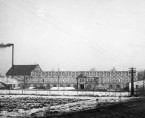Bobrek
A sub-camp located 3 km north of Oświęcim in fertilizer-factory buildings in Bobrek that belonged before the war to Anna Kuppermann and Ryfka Jakubowicz. In the late autumn of 1943, after the Allied bombing of the Berlin Siemens-Schukert-Werke, the company’s directors decided to relocate some of their production to Auschwitz.
Their representative, the engineer Kurt Bundzus, came to the camp at the beginning of November and chose 120 prisoners—precision mechanics and construction laborers. From January 1944, these prisoners marched each day to Bobrek, where they worked at demolishing some buildings and renovating others, and erecting barbed-wire fencing. In April, the prisoners were lodged permanently in Bobrek. They worked in the factory hall producing parts for electric motors and accessories. They were quartered in a nearby warehouse that was dark and crowded but had central heating and showers with hot water. Because they were experts and hard to replace, they were not beaten or mistreated.
At the end of 1944, the sub-camp held 220 prisoners, mostly Polish or Hungarian Jews along with a dozen or so non-Jewish Poles and 37 women prisoners assigned to auxiliary labor and growing vegetables in the factory garden. The commandant of the sub-camp was SS-Oberscharführer Anton Lukoschek, who was in charge of a dozen or so SS men from the Auschwitz III sentry battalion. In January 1945, the prisoners were evacuated on foot to Gliwice, and then to the Buchenwald camp.
